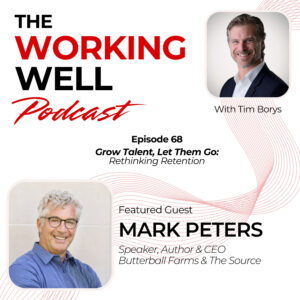
Podcast Summary
In this insightful episode of the Working Well Podcast, Tim Borys sits down with Mark Peters, CEO of Butterball Farms and author of The Retention Trap. Together, they challenge the old way of thinking about talent retention. Mark argues that the real opportunity isn’t in clinging to your people at all costs but in investing deeply in their growth—even when it means they outgrow your company.
Drawing from decades of leadership, Mark explains why thriving companies focus on developing people for their next job, how this abundance mindset builds resilient businesses, and why small to mid-market companies have a unique advantage when it comes to truly knowing and growing their people. This conversation will inspire leaders to flip their mindset, see themselves as educators, and rethink what it means to build a healthy, future-ready workforce.
✅ Key Takeaways:
Retention Isn’t the Goal: The real goal is developing people for what’s next—even if that means they leave.
Abundance Beats Scarcity: A constant flow of talent in and out keeps your organization resilient and innovative.
Small Companies’ Secret Advantage: Proximity to your people means you can personalize learning and career pathways.
Invest in Education: Ongoing learning is the next big employee benefit—and small businesses can lead the way.
Be a Community Catalyst: Companies that develop people help strengthen entire communities and talent ecosystems.
Ask Better Questions: What do your people aspire to—and how can you help them get there?
Episode Links & Resources
Connect with Mark here:
Website: http://www.butterballbutter.com/
The Source: https://i-3leadership.com/
LinkedIn: linkedin.com/in/markpetersbutterball
New Book: The Retention Trap
Podcast Highlights
Please note: This highlight is generated by a computer and may contain errors.
Welcome back to the Working Well Podcast! Today’s guest is Mark Peters, CEO of Butterball Farms and author of The Retention Trap. Today, Mark joins us to discuss innovative strategies for tackling talent shortages by focusing on employee development. We’re talking about why investing in your people might be the smartest move your business can make.
On Talent Shortages
Solving your talent shortage has nothing to do with job boards, recruiters, or retention bonuses, and everything to do with how you grow your people. This discussion delves into the limitations of current retention strategies and presents alternative approaches that emphasise authentic employee investment.
Planting the Seeds of Employee Development
Mark advocates for developing employees for their next job, even if it means they leave your company. He believes in fostering a culture of continuous learning, which not only benefits individual career paths but also strengthens the organisation as a whole.
Retention Rates and Employee Investment
Retention is often measured by compensation, benefits, and work environment changes. However, toxic work environments, poor management, and lack of career advancement opportunities are frequently the true reasons for employee turnover. Mark suggests that pouring into your people authentically leads to a resilient and committed workforce.
The Great Salt Lake vs. Great Lakes Analogy
Mark uses this analogy to emphasize the difference between a stagnant company culture and a dynamic, flowing one. Would you rather be a lifeless Great Salt Lake or the thriving, biodiverse Great Lakes? This mindset shift from scarcity to abundance can transform how employees view their roles within the company.
Building a Network of Companies
The conversation touches on the idea of companies collaborating to share talent and provide continuous growth opportunities. Mark highlights the importance of building a network of culturally aligned companies to facilitate talent movement and ensure employees have pathways for advancement.
The Source: Stabilising Workforce Lives
Mark introduced an initiative called ‘The Source’ that stabilises employees by supporting them with immediate needs, such as housing and transportation. This approach helps employees remain focused and productive by addressing the external factors that can destabilise their lives.
Cost of Turnover vs. Investment in Education
High turnover costs can hinder a company’s growth. Mark emphasizes the value of investing in your employees’ continuous education and career development, which often results in higher engagement and lower turnover rates.
AI and Future Workforce Changes
The discussion also explores the role of AI in workforce development and how companies can prepare for these technological shifts by proactively investing in employee education and training.
Tangible Steps for Leaders
Leaders can start by engaging in candid conversations with their teams, understanding their aspirations, and providing meaningful growth opportunities. This investment in human capital fosters a supportive and resilient work environment.
Closing Remarks
That was fantastic, Mark. Thank you for sharing your insights and strategies. If you want to learn more about Mark and his book, The Retention Trap, check out the links in the show notes.
Thanks, Tim. Remember: Investing in your employees isn’t just good for them—it’s good for your business. So go make the right choice!

